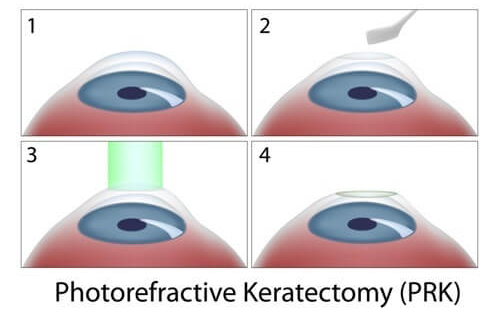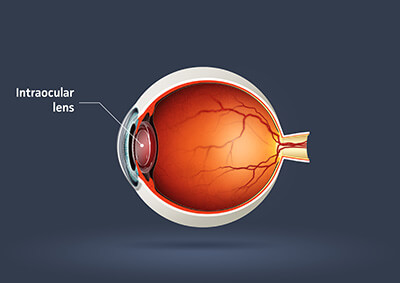Visian ICL®
The Visian ICL® is an Implantable Collamer Lens, also referred to by many as an “Implantable Contact Lens” and it works with the eye to correct vision. Unlike other lenses that are used for vision correction procedures, the collagen in Collamer, is biocompatible with the eye, meaning it is not seen as a foreign object to the body and is an excellent choice for a lens that may remain inside your eye for a lifetime.
Unlike traditional contact lenses that are placed on the surface of the eye, the Visian ICL® is positioned inside the eye between the iris (which is the colored part if the eye) and the natural lens, where it can stay indefinitely. And because it is positioned between the iris and the lens, it is invisible to both the patient and any observer.
The Visian lens is also removable, which is an appealing feature to some patients adverse to the permanency of LASIK and PRK. Visian can be removed at any time if the patient so chooses. If for some reason your vision changes dramatically at any point, the lens can be removed from the eye.
Another advantage of choosing the Visian lens is for those people who suffer from dry eye. For many people with dry eye, LASIK is not the best option.
Until recently patients with dry eyes had only the choice of PRK, which is an excellent procedure, however, the recovery is slower than LASIK and some patients just do not care for the short amount of downtime from work and their personal lives.
The Visian ICL lens is an excellent option for patients who have dry eyes and want quick visual recovery. The Visian lens does not cause or contribute to dry eyes and the Visian procedure is approximately a 15-minute surgery performed at our ambulatory surgery center and offers quick visual recovery or what is often referred to by LASIK patients as the “wow” factor.
PRK
 One of the most comprehensive procedures we provide is PRK or photorefractive keratectomy. This surgery treats nearsightedness, farsightedness, and astigmatism.
One of the most comprehensive procedures we provide is PRK or photorefractive keratectomy. This surgery treats nearsightedness, farsightedness, and astigmatism.
Although similar to LASIK surgery, PRK does not involve the creation of a corneal flap, so many of our patients who don’t qualify for LASIK can undergo PRK with no problems. This procedure does involve a slightly longer recovery period, but the payoff of seeing more clearly than you have in years is priceless.
It is a common misconception that because PRK predates LASIK, it is the less effective procedure. In reality, PRK can be an excellent option for those who are not qualified to undergo LASIK.
There are a few similarities in the way that these two procedures function to provide you with permanently improved vision, and of course, there are also differences that will dictate which is the best option for you.
The LASIK and PRK experts at New England Eye Center of Boston provide you with an individualized care plan that will optimize your vision correction and give you a chance to see the world more clearly. If you are interested in meeting with our doctors, please contact one of our Massachusetts offices to schedule your first consultation.
What is the difference between LASIK & PRK?
Both LASIK and PRK are safe and effective techniques to permanently improve vision in patients who experience near or farsightedness or astigmatism. Both procedures are virtually painless, with only a small number of patients who experience some short-lived post-operative discomfort. Serious complications are incredibly rare.
LASIK patients can expect a shorter recovery period and more immediate results; however, PRK does not require the creation of a corneal flap, making it the safer option for those who fall short of candidacy for LASIK.
Are You a Candidate?
Your candidacy for LASIK or PRK will be determined at our Boston office during your consultation and will depend on your individual case.
However, some of the Qualifications for PRK Include:
- Mild to moderate near or farsightedness
- Disqualification from LASIK due to career or leisure activity requirements
- Disqualification from LASIK due to the shape or thickness of the cornea
Both PRK and LASIK Candidates Typically:
- Are at least 18 years of age
- Have had a stable vision prescription for at least a year
- Have not experienced eye infection or injury in at least a year
- Are not nursing or pregnant
Experience Excellent Results
Both LASIK and PRK patients may have the capacity to reach 20/20 vision or better, but each person’s results are dependent on his or her individual case. The expectations you should set for your procedure will be discussed in detail with one of our doctors during your consultation.
Learn More about LASIK Surgery
LASIK and PRK can provide you with freedom from eyeglasses or contact lenses and dramatically improve your vision. With renewed self-assurance and a rejuvenated ability to see the world around you, taking life head-on will come easily to you. Our staff at the New England Eye Center is always excited to bring new patients into our community and watch as better vision changes their lives. We have a huge number of opportunities for you to improve your ocular health, so we hope that you contact our Boston office soon to schedule your first appointment for LASIK or PRK.
LASEK Surgery
 LASEK surgery is another variation of the LASIK procedure that we perform primarily for patients whose corneas are too thin for LASIK. In this procedure, a surgeon first loosens the surface cell layer (epithelium) of the cornea with a dilute alcohol solution which loosens the attachment of the epithelium to the underlying corneal connective tissue.
LASEK surgery is another variation of the LASIK procedure that we perform primarily for patients whose corneas are too thin for LASIK. In this procedure, a surgeon first loosens the surface cell layer (epithelium) of the cornea with a dilute alcohol solution which loosens the attachment of the epithelium to the underlying corneal connective tissue.
The loose epithelium is then carefully swept aside to expose the corneal connective tissue which is reshaped by the excimer laser in the usual manner.
The epithelial tissue layer is then returned into position and protected with a bandage soft contact lens that remains in place for several days. LASEK patients seem to experience less postoperative discomfort than PRK patients but their vision requires a week or more to optimize. uses an excimer.
The Bottom Line: At the NEEC Refractive Vision Correction Center, we find the time and time again that patient who has been told that they are not LASIK candidates are in fact either candidates for other forms of Laser Vision Correction or other refractive surgical procedures. Thus, it makes sense to contact us for a no-cost, no-obligation consultation.
The appropriate choice of refractive surgery performed by experienced surgeons with state-of-the-art technology can improve your eyesight and your outlook for a lifetime!
Refractive Lens Exchange

Refractive lens exchange (RLE) is also called lens replacement surgery or clear lens extraction. In this procedure, the surgeon replaces the eye’s clear natural lens with an artificial intraocular lens (IOL) to correct a refractive error and achieve sharper focus.
It is an excellent option for people with:
- High hyperopia (farsightedness)
- Presbyopia (farsightedness due to aging)
- Dysfunctional Lens Syndrome (without a cataract, symptoms include decrease in near vision, blurry or yellow-tinted vision, and difficulty driving at night)
- RLE may reduce or eliminate the need for reading glasses or bifocals in these patients. It is often the only viable option, as farsighted patients are often not good candidates for LASIK and PRK
The procedure for refractive lens exchange is nearly identical to cataract surgery. The difference is that in RLE the lens being replaced is clear, rather than cloudy due to a cataract. The recent availability of FDA-approved multifocal or accommodating IOLs has made RLE an attractive choice for many patients.




